It is commonly known as sultteook (술떡) which means rice cake made from alcoholic beverages. It is also called juengpyeon (蒸片, 증편) or jeungbyeong (蒸餠, 증병) among the yangban upper class of the Joseon Dynasty. As it is fermented with rice wine and does not go bad quickly, jeungpyeon was widely enjoyed especially in summer. This rice cake has a unique rice wine aroma, a slightly sour taste and a soft texture.
Records about jeungpyeon can be found from the "Eumsik Dimibang" (음식디미방, 飮食 知味方), the first cookbook written in Korean in the 1670s, and other cookbooks written after the mid-Joseon era. These records say that people made jeungpyeon in summer instead of other rice cake varieties like injeolmi as they get spoiled and their tastes change easily.
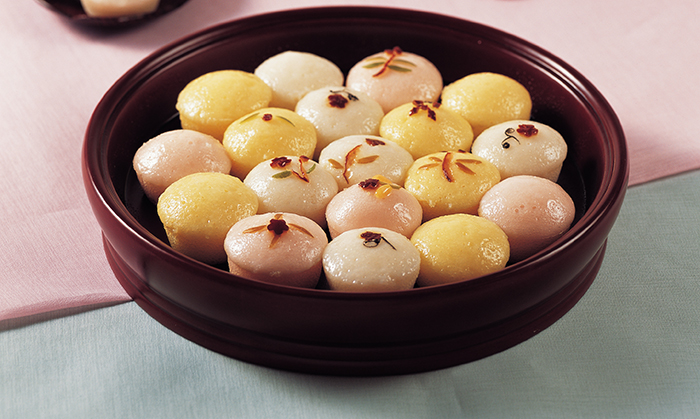
Jeungpyeon is also called sultteok as it is made from makgeoli, rice powder, yeast and other ingredients. It has been enjoyed especially in summer as it does not go bad.
** Ingredients
250 g non-glutinous rice powder, 3 g (0.25 tbsp) salt
50 g (0.25 cups) makgeoli, rice wine
100 g (0.5 cups) tepid water (40 ℃)
5 g fresh yeast
40 g (0.25 cups) sugar
garnish:
8 g (2 ea) jujubes
1 g stone mushrooms
1.7 g (0.5 tsp) pine nuts
1 g pumpkin seed
coloring:
yellow:
7.5 g (0.5 tbsp) water
2 g (1 ea) gardenia
pink:
7.5 g (0.5 tbsp) water
3 g strawberry powder
2 ㎏ (10 cups) rice wine cake steaming water
13 g (1 tbsp) edible oil
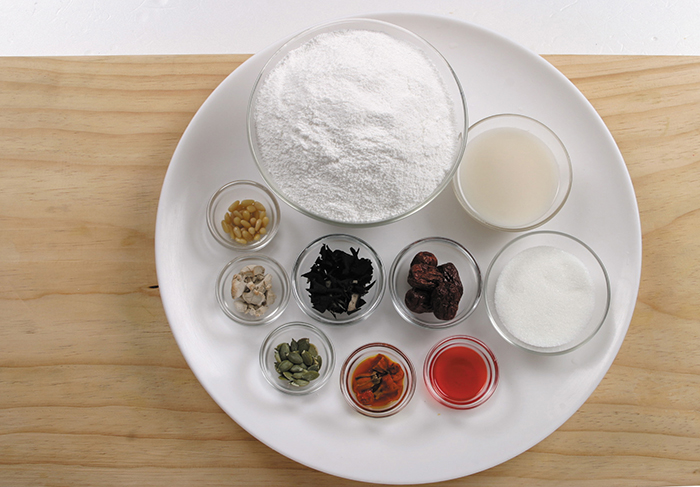
The main ingredients for jeungpyeon include non-glutinous rice powder, makgeoli, yeast, sugar, jujubes, pine nuts, stone mushrooms and strawberry powder.
** Preparation
1. Sprinkle salt over the rice powder and sieve it through a fine mesh two times. Add the makgeoli, rice wine, tepid water, fresh yeast and sugar to the rice powder. Mix them with a wooden spoon thoroughly. Place it in a container, cover with poly-vinyl film, and put it on an electrical blanket or any warm spot. Keep it warm by covering it with a thick blanket. Maintain the temperature within 40-45 degrees Celsius.
2. Ferment it for 2 hours. When the dough swells up, stir it strongly and draw the air out. Ferment it again for another 1 hour.
3. Wipe the jujubes with a damp cotton cloth, cut the flesh around, make it into a flower shape. Soak the stone mushrooms in water for 1 hour, wash it by rubbing, wipe the water with a cotton cloth, roll it up, and shred it into 0.1 centimeter-thick sliced.
4. Remove the tops of the pine nuts, wipe the nuts with a dry cotton cloth. Halve it lengthwise to make scale-like pine nuts. Wipe the pumpkin seeds with a dry cotton cloth.
5. Halve the gardenia, soak it in water for 1 hour for a yellow color. Dissolve the strawberry powder in water for a pink color.
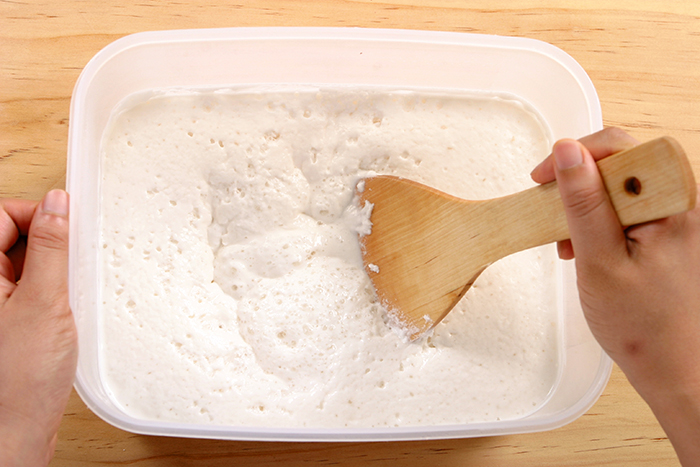
Mix the non-glutinous rice powder, salt, makgeoli, and fresh yeast to make a dough. Ferment the dough for 2 hours. When the dough swells up, stir it strongly to draw the air out. Ferment it again for another 1 hour.
** Recipe
1. When the second fermentation is completed, divide the dough into 3 parts. Leave one part for white, and color one part of the dough with 1.5 grams of gardenia water in yellow, the other part with 2 grams of strawberry water in pink.
2. Put the dough in the cake mold. Garnish with jujubes, mushrooms, pine nut and pumpkin seeds (18 ea).
3. Pour the water into a steaming pot, heat it up for 9 minutes on high heat. When it is steaming, turn off the heat, put the cake mold in the pot. Let it sit there for 10 minutes for a third fermentation and bring the water temperature to 83 degrees Celsius.
4. When the dough swells up again, steam it for 20 minutes on high heat, and for another 10 minutes on low heat.
5. When it gives off steam, take out the cakes and coat them with edible oil.
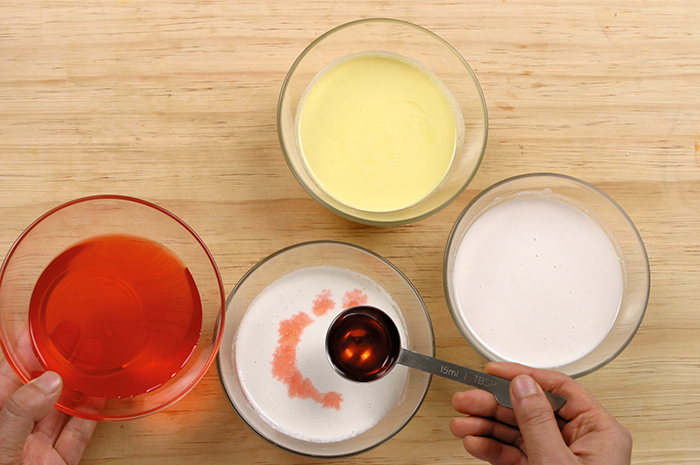
Soak half the gardenia and strawberry powder to make yellow and pink water for coloring the dough. Divide the dough into three pieces. Color two of them yellow and pink while leaving the rest of the dough white.
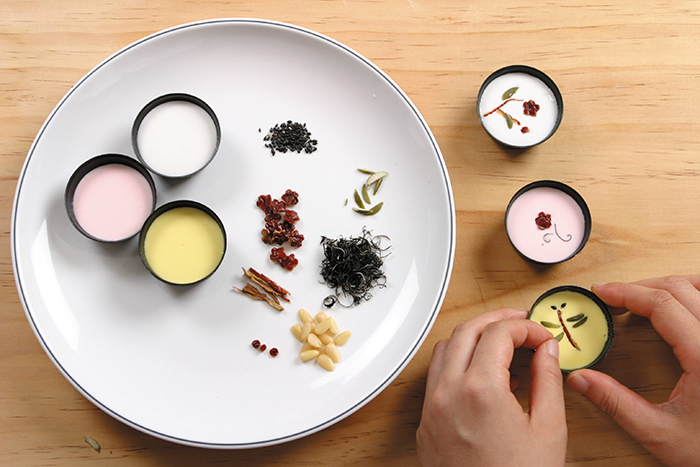
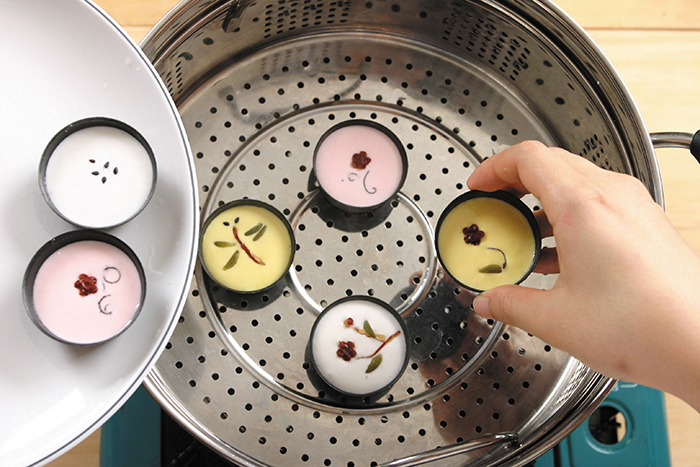
Cover the molds with cooking oil and put the dough in the mold. Place the mold in a steamer and decorate them with pieces of jujube, mushroom and pumpkin seeds on top of the molds.
Managed by Yoon Sojung
Korea.net Staff Writer
In cooperation with the Institute of Traditional Korean Food (ITKF)
Recipe from “The Beauty of Korean Food: 100 Best-Loved Recipes”
arete@korea.kr